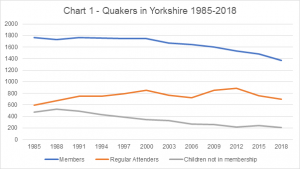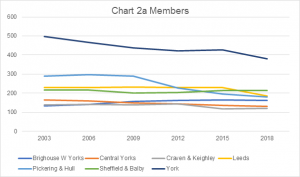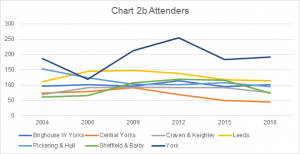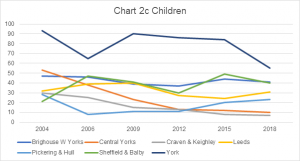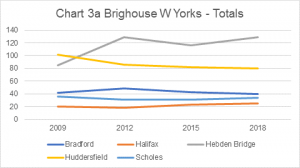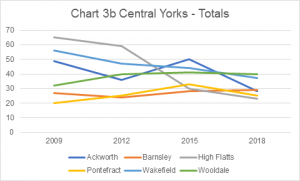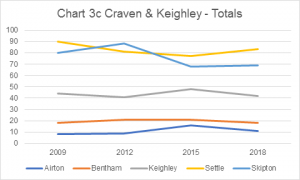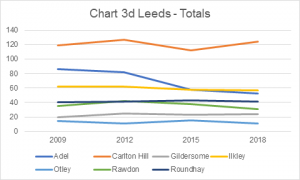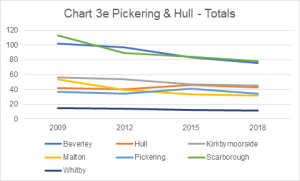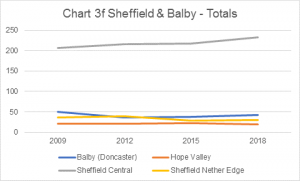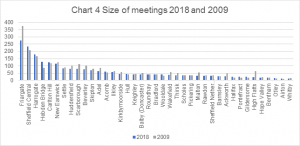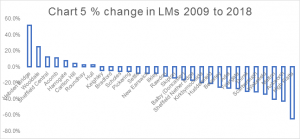GRASP Supplementary
Quakers in Yorkshire
GRASP Report and Recommendations
Supplementary Sections
Contents
- Data informing GRASP report and key findings
- Survey of membership trends
- Roles in Area Meetings in 2020
- Meeting Houses in Yorkshire
- Interim Report and Consultation
- Coronavirus lock-down and responses from meetings
- Quakers in Yorkshire history and GRASP background papers
- GRASP Nominations workshop
A. Data informing GRASP report and key findings
Data showing membership trends, the number of roles in area meetings and a snap-shot of meeting houses has been collected. This data has informed the work and recommendations of GRASP. The details are given in sections B, C and D. Here we provide a summary of the main findings.
It is often said that Britain Yearly Meeting has an ageing and declining membership. To see if this is true for Yorkshire, the trends in membership over up to 35 years have been studied (Supplementary Section B). The data comes from the annual Tabular Statement and from the triennial Book of Members and Attenders.
The number of Members in QiY was roughly constant from 1984 to 2000 but since then has shown a steadily decline of about 1% per year. The number of Attenders has fluctuated with peaks in 2000 and 2012 but is now showing a decline. The number of children (not in membership) has declined steadily over the whole period and has done so at the rate of about 4% p.a. This is four times faster than the decline in the number of members. It is this trend which is most worrying as children are tomorrows potential active Quakers. It can be concluded that the membership trend in QiY follows the national picture. Data is not collected on the age of members so the assertion of ageing membership cannot be verified. But the decline in the number of children points in this direction.
Not un-expectedly, the trend in membership numbers is not uniform across the seven area meetings. One AM, Brighouse West Yorkshire has grown by 22% over the 15-year period 2003 to 2018. Sheffield & Balby AM has been roughly constant. The other five AMs have all decreased in membership but at different rates. Craven & Keighley AM and Leeds AM have decreased by 12%; Central Yorkshire AM and York AM by 23% and Pickering & Hull AM by 38%.
These changes are reflected in the members and attenders in local meetings but with even greater variability. There have been large increases in some meetings and large decreases in others (see Supplementary Section A for details). This pattern is to be expected and has always happened. Looking over a long period indicates that some meetings grow, some decline and others remain roughly constant. This is a natural pattern and should not necessarily give cause for concern. However, the implication is that area meetings need to monitor the trends and be ready to take action. This might be by promoting a new meeting in a region of growth, or closing a meeting when the human and financial resources no longer justify continuation.
The meetings in Yorkshire generally have long histories. Supplementary Section D lists the age of local meetings in QiY indicating whether they have a meeting house and the age of the building. 32 of the 38 local meetings own their own meeting house. This is 84%, compared to 75% nationally. Many date back to the start of Quakerism. There are a lot of old meeting houses with five dating from the 17th century and another seven from the 18th century. Many meeting houses have national importance as indicated by the fact that 12 meeting houses are Listed by Historic England. The large number of old properties means that a significant financial and human resource has to be found to look after them. Interestingly, reports from local and area meetings do not indicate that Yorkshire Friends see this responsibility as being uniformly a burden. There are a few cases where the challenge is high but, in most cases, Friends are willing to spend the time and money to maintain the heritage meeting houses.
The members of GRASP undertook a survey of the number of roles in area meetings. The results are given in Supplementary Section C. The data which has been collected is only for the roles appointed by area meetings. It does not include the roles appointed to run local meetings. The data informs the discussion in Section 8 on the problems of filling roles.
B. Survey of membership trends
This appendix gives a survey of the trends in membership in Quakers in Yorkshire over periods of time. The data is derived from the annual Tabular Statements and from the QiY Book of Members and Attenders.
The Tabular Statements are published annually by Britain Yearly Meeting based on returns from each area meeting on 31 December of each year. The Tabular Statement Membership numbers should be an accurate record of Friends in membership of each area meeting. The Tabular Statement also contains the number of Attenders, but as there is no unique definition of who counts as an Attender this number is better treated with some caution. Similarly, the number of Children not in membership is included and this is also uncertain. (Children who are in membership are included in the Membership numbers). Prior to 2003, the published Tabular Statements were only for regions, meaning in our case for Quakers in Yorkshire. Since 2003, the data shows numbers for area meetings but not for each local meeting (although this is submitted and is available from Friends House).
The Book of Members and Attenders is compiled triennially from data supplied by each local meeting in Yorkshire.
Long-term trends in QiY
Chart 1 shows the trends in Members, Attenders and Children (not in membership) over the period 1985 to 2018. The data is taken from the Tabular Statements.
The number of Members was roughly constant from 1984 to 2000 but since then has shown a steadily decline of about 1% per year. The number of Attenders has fluctuated with peaks in 2000 and 2012 but is now showing a decline. The number of children (not in membership) has declined steadily over the whole period and has done so at the rate of about 4% p.a. (i.e. four times faster than the decline in the number of members). It is this trend which is most worrying as children are tomorrows potential members.
Trends in AMs 2003-2018
Charts 2a, b, c show the change in the number of members, attenders and children (respectively) in each of the seven AMs over the 15 year period 2003 to 2018.
There is significant differences in trends between area meetings. In the case of Members, Brighouse West Yorkshire AM has grown by 22% whilst Sheffield & Balby AM has been constant. The other five AMs have all decreased in membership but at different rates. Craven & Keighley AM and Leeds AM have decreased by 12%; Central Yorkshire AM and York AM by 23% and Pickering & Hull AM by 38%.
The trends for Attenders and Children show more variability. Part of this is down to the lack of firm definition of who counts as an Attenders and a child not in membership. But most of the overall decline is in three AMs: Central Yorkshire, Craven & Keighley and York.
Trends in local meetings 2009-2018
Charts 3a-g show trends in local meetings over 2009 to 2018 using the total number of entries in the Book of Members and Attenders (i.e. sum of members + attenders + children). This number indicates the total number associated with a meeting and is, of course, far higher than the number who come to meeting for worship. As expected, some meetings show big decreases whilst others show relatively big increases over the nine-year period. Thus against the general pattern of an overall decrease in numbers, there are meetings with increases which indicates that it is possible to grow numbers.
To study the changes more clearly, chart 4 shows columns for each meeting sorted into order of size for 2018 and with 2009 for total. This clearly shows the meetings which increase or decrease. To show the changes more clearly, chart 5 plots columns for the percentage change over the period 2009 to 2018. The smaller meetings (less than 30 in 2009) have been omitted as the % changes are less meaningful.
Out of the 30 meetings on chart 5, 8 meetings show increase over the 2009 to 2018 period. The largest positive increases are Hebden Bridge (52%), Wooldale (25%), Sheffield Central (12%), Acomb (11%) and Harrogate (8%). There is a group of meetings who either show small increases or small decreases and then a long tail showing significant decreases with the three at the end of High Flatts (65%), Ackworth (43%) and Malton (41%). It should be noted that the above figures are simply snap-shot totals at two dates. The next Book of Members in 2021 might show different trends.
Other information which can be deduced from the data:
(a) the median totals have decreased from 50 in 2009 to 40 in 2018.
(b) Chart 4 indicates that 45% of the total in Quakers in Yorkshire is in the six largest meetings with a large number of meetings clustered around the median and a tail of small meetings. There are six meetings less than 20 and twelve meetings less than 30.
Apart from Otley, which closed in 2018, the other small meetings seem to be able to survive either by being looked after by a larger meetings, or having special circumstances.
C. Roles in Area Meetings in 2020
This is a survey of the number of roles to be filled in the 7 Area Meetings which make up Quakers in Yorkshire (QiY).
Within the QiY region, there are roles to be filled associated with:
- The 38 Local Meetings. The number of roles varies considerably and is generally proportional to the size of the meeting. A small meeting can survive with the sharing of essential tasks among the members and attenders. A large meeting needs to ensure that tasks are completed so traditionally has appointed a committee of Friends.
- The 7 Area Meetings. See below.
- Quakers in Yorkshire. This is divided into:
- Roles to run QiY. Most of these are listed on the AM table (below). In addition, there are 4 officers (2 co-clerks, Treasurer, Clerk of Trustees).
- Young people’s groups (totalling 12 roles)
- Appointments made by QiY to external bodies which includes governors for Breckenbrough, Bootham and The Mount schools and trustees of Glenthorne Quaker Centre (totalling about 32 roles).
The main table on the next sheet shows the number of roles in the 7 AMs. This was compiled by data supplied by each member of GRASP who did a survey of roles in their AM. Most of the information was provided by AM Nominations Committees which does mean that if roles are appointed by another group (e.g. AM trustees) the roles may not be included in the table.
The data should be regarded as a ‘snap-shot’ of the types of roles. It will change with time. Nominations Committees may not be able to fill all the roles so the actual number of Friends serving will be less than shown in the tables.
There is a total of 399 unique roles plus 249 Elders and Overseers (who look after the spiritual and pastoral needs of meetings and members). The 399 roles mean an average of 57 roles per AM, varying between 44 and 74 roles. These totals are not proportional to the difference in size of the AM membership. The table below shows the number of members for each role in the seven area meetings. As expected, the larger the area meeting, there are more members available to fill the roles.
| AM | No of members
(31 Dec 2018) |
No. of roles | Members per role |
| Brighouse W Yorks | 162 | 49 | 3.3 |
| Central Yorks | 130 | 55 | 2.4 |
| Craven & Keighley | 121 | 44 | 2.8 |
| Leeds | 184 | 63 | 2.9 |
| Pickering & Hull | 179 | 74 | 2.4 |
| Sheffield & Balby | 213 | 53 | 4.0 |
| York | 381 | 61 | 6.2 |
The roles in Area Meetings have been grouped together as follows:
- AM core roles. These are needed for each AM to function and include those needed to clerk the AM, to run the finances, and by national regulation (trustees, registering offices etc.). There are 224 core roles (averaging 32 each AM).
- AM national and regional roles. These are either required by yearly meeting or another semi-national body. There are 54 roles. (Note that only 2 AMs report sending someone to Junior Yearly Meeting though each AM can have two places).
- QiY roles. There 41 roles (see note above).
- AM specialist or unique roles. Most of these are concerned with representing Friends on external bodies and are hence important roles. The number varies considerably across the AMs, due mainly to the characteristics of the area (such as whether there are prisons in the area).
| Area Meeting Appointments Data compiled mainly from AM Nominations Committee records so there may be gaps where others do the nominating/appointing. |
Brighouse W Yorks | Central Yorkshire | Craven & Keighley | Leeds | Pickering & Hull | Sheffield & Balby | York | TOTAL | |
| Number of Local Meetings | 5 | 6 | 5 | 6 | 7 | 4 | 5 | ||
| AM core roles | |||||||||
| Clerk (or Co-Clerks) | 1 | 1 | 1 | 2 | 3 | 3 | 1 | 12 | |
| Assistant Clerk | 1 | 1 | 1 | 1 | 4 | ||||
| Membership Clerk | 1 | 1 | 1 | 1 | 1 | 1 | 6 | ||
| Treasurer | 1 | 1 | 1 | 1 | Paid | 2 | 1 | 7 | |
| Assistant Treasurer | 1 | 1 | 2 | ||||||
| Treasurer Support Team | 2 | Paid | 2 | ||||||
| AM Trustees (Note 1) | 6 | 8 | 11 | 6 | 11 | 10 | 52 | ||
| AM Finance and Property Committee | 6 | 7 | 5 | 18 | |||||
| Independent Examiners | Paid | Paid | Paid | 0 | |||||
| Nominations Committee | 7 | 10 | 7 | 7 | 7 | 6 | 10 | 54 | |
| Registering Officer (and deputy) | 2 | 2 | 1 | 1 | 2 | 1 | 2 | 11 | |
| Children and Young People’s Advocate | 1 | 1 | 1 | 1 | 1 | 5 | |||
| Safeguarding coordinators | 2 | 2 | 2 | 3 | 7 | 2 | 3 | 21 | |
| Safeguarding committee convenor | 1 | 2 | 3 | ||||||
| Data protection coordinator | 1 | 1 | 2 | ||||||
| Custodian of Records/Archivist | 1 | 1 | 1 | 1 | 2 | 1 | 7 | ||
| Newsletter editor | 1 | 1 | 1 | 2 | 2 | 7 | |||
| AM website | 3 | 2 | 1 | 1 | 7 | ||||
| Friend to be informed of deaths (at AM level) | 1 | 1 | |||||||
| Examiner of marriage extracts | 1 | 1 | 1 | ||||||
| Media contact | 1 | 1 | |||||||
| Register of Members/Tabular Statement | 1 | 1 | |||||||
| Health and Safety Coordinator | 1 | 1 | |||||||
| AM national (and regional) roles (Note 2) | |||||||||
| Meeting for Sufferings Representative and Alternate | 2 | 2 | 2 | 2 | 2 | 2 | 2 | 14 | |
| Quaker Life Representative (and deputy) | 1 | 2 | 1 | 2 | 2 | 2 | 2 | 12 | |
| Northern Friends Peace Board representative (and deputy) | 2 | 2 | 1 | 1 | 2 | 2 | 1 | 11 | |
| QPSW Correspondent | 1 | 1 | 2 | ||||||
| QCCIR correspondent | 1 | 1 | |||||||
| Junior Yearly Meeting | 2 | 2 | 4 | ||||||
| Young Friends General Meeting | 1 | 1 | 1 | 3 | |||||
| Ackworth General Meeting Representative | 2 | 1 | 1 | 1 | 1 | 6 | |||
| Leighton Park General Meeting Representative | 1 | 1 | |||||||
| Quakers in Yorkshire roles | |||||||||
| QiY Nominations Committee | 1 | 2 | 2 | 2 | 2 | 2 | 2 | 13 | |
| QiY Trustee | 1 | 1 | 1 | 1 | 1 | 1 | 1 | 7 | |
| QiY Outreach Projects Committee | 1 | 1 | 1 | 1 | 1 | 1 | 1 | 7 | |
| QiY Arrangements Committee | 1 | 1 | 1 | 1 | 1 | 1 | 1 | 7 | |
| GRASP | 1 | 1 | 1 | 1 | 1 | 1 | 1 | 7 | |
| AM Specialist or Unique roles (Note 3) | |||||||||
| Prison Chaplain or Minister | 1 | 2 | 1 | 2 | 6 | ||||
| Prison Ministry Support Group | 1 | 1 | |||||||
| Burial Committee | 2 | 7 | 9 | ||||||
| Trustees Grants Committee | 2 | 2 | |||||||
| Sanctuary meeting representative | 2 | 2 | |||||||
| Barnsley/Thomas English Trustee | 9 | 9 | |||||||
| Observer to York Synod | 1 | 1 | |||||||
| SACRE representative (Note 4) | 1 | 1 | 2 | ||||||
| University chaplain | 1 | 2 | 3 | ||||||
| Leeds University Chaplaincy Trustee | 1 | 1 | |||||||
| Leeds Swarthmore Council | 2 | 2 | |||||||
| Leeds City Council Peace Link Group | 2 | 2 | |||||||
| Leeds Hospital Contact | 1 | 1 | |||||||
| Bedford Court Committee | 2 | 2 | |||||||
| Halifax Meeting House Charity | 5 | 5 | |||||||
| Glenthorne Planning Group | 3 | 3 | |||||||
| AM List secretary and deputy | 2 | 2 | |||||||
| Trustee for Bamford community | 1 | 1 | |||||||
| Insurance matters | 1 | 1 | |||||||
| Minutes Indexer | 1 | 1 | |||||||
| James Reckitt Charity AM Trustee | 1 | 1 | |||||||
| Learning & Development Group | 4 | 4 | |||||||
| Acklam Fund Administrator | 3 | 3 | |||||||
| Worfolk Cottages Committee & Convenor | 6 | 6 | |||||||
| Ravensworth Lodge | 1 | 1 | |||||||
| Resident Friends (unpaid but with accommodation) | 5 | 2 | 7 | ||||||
| Total roles | 49 | 55 | 44 | 63 | 74 | 53 | 61 | 399 | |
| Elders & Overseers | |||||||||
| Elders | 15 | 14 | 10 | 18 | 21 | 13 | 32 | ||
| Overseers | 15 | 12 | 11 | 21 | 16 | 13 | 38 | ||
| 30 | 26 | 21 | 39 | 37 | 26 | 70 | 249 | ||
| Grand Total | 79 | 81 | 65 | 102 | 111 | 79 | 131 | 648 |
Note 1: Central Yorkshire is not yet a registered charity. The other 6 AMs are registered. In some cases Trustees make appointments not listed here, e.g. Independent Examiners.
Note 2: The first 3 roles are ‘compulsory’. The others depend on practice and availability of Friends.
Note 3: Each AM has evolved ways of working and supporting the activities in their area. This has led to diverse roles.
Note 4: QIY represents SACRE in North Yorkshire
D. Meeting Houses in Yorkshire
There are currently 38 meetings in the Quakers in Yorkshire area and 32 of them have their own meeting house[1]. This is a high proportion compared to the whole Yearly Meeting. Of the 6 who do not own a meeting house, one, Ackworth, uses the School meeting house and another, Hope Valley, uses the premises of the Bamford Quaker Community. The other 4 use rented premises, with Halifax worshipping in the old meeting house which had previously been sold.
The table below shows the meeting, the date started, whether they own a meeting house, the date the meeting house was built or bought, and whether the building has Historic England Listed status.
| Area Meeting | Local Meeting | Date meeting started | Meeting House Now? | Date Meeting House built or bought | Listed |
| Brighouse West Yorkshire | Bradford
Halifax Hebden Bridge Huddersfield Scholes |
1652
1678
1770 1652 |
Yes
No No Yes Yes |
1995
1770 1883 |
|
| Central Yorkshire | Ackworth
Barnsley High Flatts Pontefract Wakefield Wooldale |
1779
1660 1678 1655 1652 1665 |
[School]
Yes Yes Yes Yes Yes |
[1848]
1969 1697 1998 1965 1689 |
Grade II
Grade II |
| Craven & Keighley | Airton
Bentham Keighley Settle Skipton |
1658
1665 1653 1661 1653 |
Yes
Yes Yes Yes Yes |
1700
1768 1936 1678 1693 |
Grade II*
Grade II
Grade II* Grade II |
| Leeds | Adel
Carlton Hill Gildersome Ilkley Rawdon Roundhay |
1870
1652 1705 1689 1655 1927 |
Yes
Yes Yes Yes Yes Yes |
1928
1987 1756 1868 1697 1931 |
Grade II
Grade II
|
| Pickering & Hull | Beverley
Kirkbymoorside Hull Malton Pickering Scarborough Whitby |
1702
1689 1687 1671 1675 1676 1659 |
Yes
Yes Yes Yes Yes Yes No |
1961
1789 2005 1823 1793 1990
|
Grade II
Grade II* Grade II
|
| Sheffield & Balby | Balby (Doncaster)
Hope Valley Sheffield Central Sheffield Nether Edge |
1652
1669
|
Yes
No Yes No |
1975
1989
|
|
| York | Acomb
Friargate Harrogate New Earswick Thirsk |
1905
1659 1665 1917 1666 |
Yes
Yes Yes Yes Yes |
1911
1816 1966 1988 1799 |
Grade II |
A number of features can be deduced from the data in the table.
70% (27) of Yorkshire meetings started before 1700 with six dating back to 1652. Only six started after 1900. So most local meetings in Yorkshire have a long history, with many dating from soon after the start of Quakerism in 1652. This reflects the fact that George Fox came to Yorkshire in 1651 where he found many Friends who were seeking a new faith and Fox’s message strongly resonated. George Fox travelled north west out of Yorkshire to Pendle Hill, Firbank Fell and Swarthmoor Hall in summer 1652. This date is taken as the start of the Quaker movement because this year an organisation was put in place to support Friends who spread across the country to spread the Quaker message.
The average age of the meeting houses is not as old the meetings themselves. Many buildings have been re-built, often a number of times. However, we do have five meeting houses date from the 17th century with another seven from the 18th century. 15 meeting houses were built in the 20th century. The old age of many meeting houses increases the resources needed to support the premises. This is made up of regular maintenance plus the high cost of refurbishing and adapting the premises to comply with modern accessibility and comfort requirements.
A consequence of the old age of many meeting houses is that many of them are classed as heritage properties because they contain features which are nationally considered worth preserving. The Historic England Listed Classification system puts properties into one of three categories: Grade I (highest with only a few outstanding properties), Grade II* and Grade II. In Yorkshire we have 12 meeting houses with listed status (38% of all meeting houses) (see table). Compared to the national picture of places of worship, this is an exceptionally high number. Three meeting houses have been given Grade II* (Airton, Malton, Settle).
Compared to the rest of the yearly meeting, Yorkshire has a high proportion of owned Meeting Houses. Just owning and maintaining a building is a significant responsibility which takes up time and resources. Having a large number of old and listed buildings is an additional factor. A building of any age can require large sums of money to be spent on maintenance.
[1] In the area of North Yorkshire there are four meeting houses which are outside Quakers in Yorkshire: Bainbridge and Leyburn in Wensleydale & Swaledale AM and Great Ayton and Osmotherley in Teesdale & Cleveland AM
E. Interim Report and Consultation
In January 2020 GRASP published an Interim Report for consultation. The report was intended to start the process of meetings considering reinvigoration and simplification as well as to sense the appetite for change. It was launched at the January 2020 QiY Quarterly Meeting which also heard from Jonathan Carmichael, the BYM Simpler Meetings Projects Officer.
In the following two months many local and area meetings started to engage with the issues. Many intended to devote more time to consideration in the Spring and Summer of 2020. The coronavirus pandemic lock-down intervened to delay the process. Consequently, the detailed consideration has been stretched over a longer period of time. Some meetings have already devoted a lot of time to consideration and submitted detailed responses. Other meetings have expressed the view that the simplification agenda was less important than the climate crisis and that the need to tackle the climate emergency ought to be our top priority. A number of area and local meetings did consider the subject and minutes have been received from them. GRASP is grateful to the time which meetings have given to the subject.
The general response was to welcome the Interim Report with a general recognition of the need to simplify in order to free up resources for worship and witness. The broader picture was often over-shadowed by local issues, particularly the difficulty of finding Friends to fill roles, e.g. clerks (see section 8). A number of meetings reported that they were looking at the future of eldership and oversight and how to care for Friends, both spiritually and pastorally. Sharing the two roles is being actively considered.
An on-line survey was created by Tim Herrick to enable Friends to respond individually. There has not been a large number of responses but those that did use this method agreed with the responses from meetings and offered helpful comments.
The Interim Report asked Friends and meetings to respond to five questions:
- Are you content with our sense of the core aspects of Quakerism and the challenges we are currently facing?
- Out of the options identified in the report, which is the priority for your local and area meeting for reinvigoration and simplification?
- What would help you to achieve reinvigoration and simplification?
- What are the smallest changes which might make the biggest differences?
- What opportunities have we missed?
The responses showed almost universal agreement with the cores aspects of Quakerism listed in the Interim Report (see section 4). The only omission was the feeling that there ought to be direct mention of our testimonies. (This core aspect has now been added). The clear priority for meetings is the desire to reduce the number of roles and on a higher level to consider whether it is feasible to reduce the number of charitable units. There is the recognition that these aims are not easy to achieve.
Many meetings said that help and advice to achieve change would be appreciated. This might be a task for Friends external to the local/area meeting. It was often noted that before there can be change, there needs to be the strong desire to consider change. This requires a different mind-set than is needed to run the day-to-day activities of meetings. The 4th question did not lead to many responses, other than the sentiment that the most difficult task is to just get started on making changes. There was general agreement that GRASP seems to have covered the main opportunities for simplification.
A final common response was that all change must be made with spirit-led discernment.
F. Coronavirus lock-down and responses from meetings
The coronavirus pandemic is one of the biggest shocks to Quakerism in its 370-year history so the long-term impact on Quaker organisation could be great. We have already noted how it has delayed consideration of the GRASP agenda. In this section we note the changes the coronavirus lock-down has made, and is making, on the way we do things. It is a case of change being forced upon us suddenly and meetings having to adapt. In March 2020 the government decided at short notice to have a period of lock-down which meant self-isolation for individuals, no gatherings of people and the immediate closure of all places of worship. Friends and meetings had to react quickly. As expected, the rate at which meetings put in place responses depended on the initiative and experience of local Friends. After the initial shock, meetings responded with the strong desire to keep the worshiping community together.
The pandemic has made us change the way we do things and some of these changes may be permanent. Large gatherings and travel are likely to be reduced for some time and may not return to pre-lock-down levels. As meeting houses reopened, they have had to adapt to new norms for hygiene and social distancing to stop the spread of the virus.
During lock-down there were many innovative uses of virtual meetings. This has often kept local and area meetings together. But we have noticed a clear divide between the IT literate and those who do not wish to, or are not able to, use IT. This is not necessarily age related.
Most Local Meetings in Yorkshire have used virtual meetings for worship, generally with the zoom platform. The rate of uptake has depended on the level of technical experience available. The near ubiquitous availability of smartphones, tablets and laptops has made it easier to arrange zoom meeting for worship and now, for some meetings, blended worship which combines physical and online worship.
There are some advantages of virtual meetings for worship over physical meetings. These include: enabling geographically dispersed participation; multiple meetings in the week; and enabling participation by those who are unable to come to a physical meeting. But there are also disadvantages, most notably the lack of networking and social interaction which makes keeping meetings together as a community more difficult.
Virtual meetings have been used for many other purposes, such as poetry groups, art classes, learning groups, all with the aim of cementing the community together. Children’s meetings have been run virtually in some meetings. Virtual meetings have been particularly successful with young people and attendance has sometimes gone up. Young people are often able to point us in new directions.
Meetings have started to grapple with how to continue Quaker witness which necessarily has taken a back-seat during the lock-downs. Looking ahead there are issues as to how to do outreach and how to maintain Quaker networking. Most local meetings have not publicly advertised their online meetings and this may make it more difficult for new enquirers to find us. Blended meetings have been tried. These combine some Friends physically present in a meeting house and other Friends interacting over Zoom. At this stage it is not yet clear whether they are the best, or worst, of both worlds.
A digital divide has emerged between Friends who are confident with new technology and Friends who do not have access to technology, or do not wish to use new technology. This has created a new diversity among Friends. Meetings are dealing with this diversity sensitively and are aware of the importance of maintaining and enhancing inclusive Quaker communities.
Virtual business meetings have been successful, helped by the circulation of draft minutes. Some local meetings have held more, shorter, business meetings. Area Meetings have met using zoom.
Clerks have found virtual meetings to be challenging. Sensing the wishes of the meeting is more difficult. Discernment is different and there is a danger that the Quaker business method is diluted. Controversial issues seem to have been avoided by clerks. There has been wide use of draft minutes circulated before meetings. This can be a good way of doing business but there is also the danger that the spiritual discernment of the gathered group is altered.
The reduction in the financial income of meetings has been severe. This will be made worse by reduced income from lettings for some time into the future. Consequently, AM Trustees are having to grapple with many issues that they did not expect. We have a lot of meeting houses which need resources to maintain. The implications for the financial and human resources might need to be reconsidered. The goals for simplification may become more important driven partly by financial imperatives.
There is an opportunity to think about how new ways of doing things have enhanced or inhibited worship and witness in both local and area meetings. There is a tension with this and a perhaps natural desire to ‘go back to how it was before’ as soon as possible. Given the need and desire for change, it would be sensible for meetings to reflect on what they have learnt during coronavirus and what they want to keep or do differently going forward.
G. Quakers in Yorkshire history and GRASP background papers
- History of Quakers in Yorkshire
- Quakers in Yorkshire Minute – April 2019
- Guidelines for GRASP
- Summary of small group discussions at Quakers in Yorkshire 27/4/2019, Doncaster
History of Quakers in Yorkshire
Quakers in Yorkshire can trace its history continuously back to 1665 when the first recorded minutes exist of Yorkshire Quarterly Meeting. Quakerism started in Yorkshire and North-West England in 1651-52 when George Fox and other founders discovered a faith that they had been seeking. The early years were ones of rapid expansion, religious fervour and considerable persecution of Friends. In the 1660s George Fox established a hierarchy of meetings to provide networks and support. The Preparative (now Local) Meetings fed into the Monthly (now Area) Meetings who fed into the Quarterly Meetings who reported to London Yearly Meeting.
Yorkshire Quarterly Meeting has met quarterly since 1665 and played an active part in the life of Quakerism both regionally and nationally. Outreach work was important in the 20th century. A special committee to do outreach was formed called the 1905 Committee which became the Yorkshire Friends Service Council in 1928 and Quaker Outreach in Yorkshire in the 1980s. As needs change, this has now been laid down and replaced by an Outreach Projects Committee. Activities for young people have also been important. In the 1930s the Yorkshire Friends Holiday School was established and has met annually since then.
In 1966 Yorkshire Quarterly Meeting became Yorkshire General Meeting as part of a simplification of the administrative structure of the yearly meeting. In 2005 the name was changed to Quakers in Yorkshire. In 2007 the regional gatherings ceased to be part of the administrative structure of Britain Yearly Meeting. In 2010 Quakers in Yorkshire became a separately registered charity (Number 1139514) and has a group of trustees nominated by area meetings and appointed by Quakers in Yorkshire.
Quakers in Yorkshire organises quarterly meetings covering the work and witness of Quakers and supports witness done on a pan-Yorkshire basis. It supports outreach activities through the Outreach Projects Committee. It sponsors an annual Easter Settlement and activities for under 19s (Junior Holidays, Yorkshire Friends Holiday School). It appoints half the trustees to Glenthorne Quaker Guest House in the Lake District. Grants to improve meeting houses and provide support to undertake outreach and the care and nurturing of children and young people are given by the trustees of Quakers in Yorkshire.
Quakers in Yorkshire Minute – April 2019
QiY 19/04/05 Reinvigorating Quakerism – Paul Parker, Recording Clerk
Paul gave us the background to his thoughts on this by reading 10.02 of Quaker Faith and Practice. He reminded us of the transformative power of coming to meetings for worship and of the efforts of early Friends to get to meeting. It is important to make sure this is about transformative change in worship and in our lives.
Paul has reminded us that the world is a better place for having Quakers in it. It is important for us to think about this in the context of the more secular, more regulated and more pressured world in which we live. Quakerism is not so visible and the voice of faith is often seen as less relevant. We have changed as well: there are fewer Quaker families and many examples of single Quakers in households. Quoting last year’s Tabular Statement, he confirmed the continuing decline in membership: a14% decline in ten years. The median number of members in meetings is 18 (down from 24 ten years ago) which means possibly 11 or 12 people typically attend meeting on a Sunday. There are 250 meetings like this. We are asked if we need 70 area meetings and so many tiers of decision making. We need to respond to these changes at national, local and individual level in order to survive.
The evaluation of the experimental Vibrancy in Meetings project, in which Britain Yearly Meeting (BYM) staff work alongside local meetings, has shown that workers have been able to support local meetings in various ways, including navigating the decision-making process. This has prompted BYM trustees to launch a Simpler Meetings Pilot Project, the object of which is to bring about a simplification of procedures, structures and overall governance so that we produce thriving communities. Having regional workers could modify the relationship between local meetings and Friends nationally. Already, six BYM staff live in Yorkshire. By considering local, national and individual changes and working across meetings, we might be able to reinvigorate ourselves and how our lives and communities speak to the world. This will make Quakers sustainable as an organisation and able continue to transform lives. Thinking laterally should release energies.
We have shared thoughts in groups, on 1) What opportunities there might be for reinvigorating Quakerism in Yorkshire and 2) What needs to be kept and lost? There were many positive proposals and also a number of negative comments about the burdens experienced by post holders. The comments will be collated and circulated to meetings with the minutes.
In our plenary, we have heard that Friends would wish to unite with the principle of further exploring ways to bring about simplification. We recognise that it is for individual area meetings to also unite with this and it is important that each is engaged. As a means to achieve this, we ask that this minute, together with a summary of the group contributions, be sent to the clerk of each area meeting for Friends’ consideration. Our proposal, should they agree, is that they appoint a representative to participate in a working group to take this forward. We ask Quakers in Yorkshire (QiY) trustees to convene the first meeting. The group should then appoint its own convenor and prepare terms of reference in consultation with QiY trustees. We ask representatives from meetings today to undertake to engage their area meetings and ask those interested in participating in the working group to sign a sheet.
We thank Paul for a most persuasive presentation which has stimulated us to take action. We hope to hear an update on this early next year.
Guidelines for GRASP
- Background
- At Quakers in Yorkshire’s April 2019 meeting, Paul Parker, Recording Clerk of BYM spoke on the subject ‘Reinvigorating Quakerism’ as part of Britain Yearly Meeting’s Simpler Meetings Pilot Project. This aims to simplify our structures and processes in order to release time and energy so that Friends can focus on the power of the Spirit to transform our individual lives and thus the Society’s spiritual life and future. He saw Yorkshire Friends as having a significant role. QIY’s continuance as a distinct regional group gives it the potential to serve as a model for reinvigoration of other meetings across BYM through cooperation on a regional basis.
- A wide range of suggestions came out of the lively group work and open discussion which followed. The final minute expressed the meeting’s clear hope that Friends would ask that their Area Meetings should each appoint a Friend to join a small working group, to be set up to take the initiative forward.
- Although Quakers in Yorkshire is not part of the governance structure of BYM and its constituent AMs, as the sole Yorkshire-wide body of Friends it is in a position to facilitate this important work in the first instance, and to be a forum for future discussion, as required. The terms of reference guidelines for this group follow.
- Purpose of working group
- To explore ways in which our seven AMs might simplify structures, governance and proceedings and work together where appropriate, so as to create conditions that help meeting communities to grow, thrive and flourish.
- Composition of the group
- Membership will consist of one keen person from each of QIY’s seven AMs. The clerk of QIY trustees (QIYT) will convene the first meeting. The group members will choose a convenor and determine the mode of clerking for the duration of the work.
- The group may co-opt up to two members if appropriate
- Including such co-option(s), there shall not be more than two members from any one Area Meeting
- Responsibilities/remit
- The group is encouraged to think broadly, radically, laterally, as led. This thinking may include, but not be confined to the following areas, which are given only as examples:
- streamlining of administrative tasks within AMs, sharing tasks between neighbouring AMs where appropriate, or employing paid staff.
- organising care for the spiritual health of meetings, such as eldership, oversight, nominations, welcoming practices and scope for sharing ideas between AMs
- Making recommendations for the practical implementation of proposed changes and the next steps to be taken.
- It is assumed that during the process members of the group will consult with relevant post-holders in their own AMs.
- Overall
- To consider principles as well as structures, and to think laterally (not simply same structures, bigger scale), and how could simplifying help in practice to grow Quaker numbers?
- Duration and Reporting
- Ideally, to produce, within four months of the group’s first meeting, a brief progress report to the clerk of the trustees of Quakers in Yorkshire.
- Ideally, to produce, within six months of the group’s first meeting, a paper which would be the basis for wide consideration by those Area Meetings (including their trustees) that are members of Quakers in Yorkshire.
- Meeting
- Initially to meet in person, thereafter as agreed by the group. Travel costs to be reimbursed by area meetings.
- Links
- Group members will keep in close touch with their own Area Meetings and their own AM trustee member of QIYT
- The Group will keep in touch with QIY trustees through QIYT clerk. To keep in touch with QIY as and when requested by QIY.
- Notes from small groups at QIY meeting in April 2019 will be available.
- Larger Parameters
- Our Quaker principles and testimonies in their deepest and broadest interpretation
- Underpinning of the regulatory charitable framework for good governance and
practice
- Duration of task
- This will depend upon the outcome of the consideration by Area Meetings after six
months (Para 6.2 above). Extension beyond six months will be a decision of these AMs.
- Future role, if any, of Quakers in Yorkshire/QIYT
- This will only become apparent in the light of the working group’s report, its reception by the participating AMs and the implications of any changes agreed by them.
Summary of small group discussions at Quakers in Yorkshire 27/4/2019, Doncaster
Background Paul Parker began by pointing out our steadily declining membership. He referred to a BYM Trustees meeting at Swarthmoor Hall in 2018 when clearness emerged on our need to become a ‘Simple Church supported by a Simple Charity’.
This was taken up by Sufferings, encouraging us to look at how we can simplify our structures so as to free up time and energy for our spiritual life and the Society’s future. We broke into small groups to consider two questions:
- What opportunities can you see for re-invigorating Quakers in Yorkshire? [i.e. generally]
- What would you keep and what would you lose?
Fourteen groups reported to the plenary session. From one we got What would Re-invigorated Yorkshire look like? What’s the Vision? – More people? More life of the Spirit/vigour? How then? – Do we need a “re-boot”? Or, horticulturally, a “vigorous prune”?
Key typical points selected from the others on the general theme were as follows.
Structures (Note frequency of paid assistance)
Committees Our committees/roles can be v. burdensome; Do we need all the committees? Paying admin work across L/AMs; Small meeting (Hope Valley): changing team of three do everything. AM does the finance’; Silly rules and inflexibility.
Regional Premises and finance cropped up frequently, as did suggestion of paid assistance.
- Premises: Managing QMHs – done on a wider area – + paid. (cf London); Be prepared to make difficult decisions (including about buildings); Old/money draining local MHs sapping our energy; Too much property (esp. Listed Buildings)
- Treasurers etc – Identifying what could be done at regional level e.g. safeguarding, treasurer; minimise roles or regionalise them; Restructuring geographically//Paid AM treasurers. AMs. Only need one and one set of trustees; Sharing resources by paying one person to deal with work of several treasurers; an AM having one treasurer and a part-time book-keeper (Bristol AM??); Central England AM?
- Clerks: support regionally. Quaker Business Method on clerks (3.20) – too much work?
- General: Build on existing structures: QIY, Cober Hill, Summer Hols, Summer School,
Summer Shindig etc. QIY Outreach C’ee/NFPB; Positive that we have QiY’.
- Local/AM level Pooling small jobs – paid worker.
Outreach and Social Witness Open days at MHs; Quaker Quest still in London; Young people and Extinction Rebellion etc…; Stalls with activities at events you are attending; Talk to people; Social Witness first then “by the way, I’m a Quaker …”; Sharing on Social Media; Go out to join with active groups; More openness about being Quakers – leafleting?
Young people potential of Quaker schools for future membership largely untapped; Youth worker based in Sheffield; Where does YFGM fit in in Yorkshire; Relevant campaigning (Extinction Rebellion etc); QiY existing activities (see also under ‘Structures’ above).
Regional/national activities that do something – e.g. musicians, poets etc; More regional meetings.
Local Meetings Different times for meetings; More attention to drawing attenders in – small roles etc.; Larger meetings support smaller ones; ‘Apprentice’ overseers; Getting to know each other in things spiritual to balance structures and systems; Being open to challenge – work on this as a meeting; Flexibility – allow people to breathe; People like to do smaller jobs; Be aware of what makes us look exclusive … language, “we’re different” etc.
General Use the gifts that we have been given. Re-kindle the joy of the spiritual.
What next? Simplify our internal roles and structures at all levels, to release energies for the contemporary challenge of spiritual and membership re-invigoration.
H. GRASP Nominations workshop
- Held by Zoom on 21 November 2020.
- 25 Friends present (at least 3 from each AM)
- Willing and Able 17-minute video and accompanying video available on Quakers in Yorkshire website.
Summary of contributions at workshop
Background
The aim of the workshop was to bring Friends involved in nominations together to make connections, and for sharing challenges and possible solutions. Those participating had lots of experience of AM nominations committees, but also at local meetings, Quakers in Yorkshire and nationally.
After worship and an introduction, we divided into 4 break-out rooms to start to build relationships, and to discuss our main challenges and solutions. This sharing helped to get ideas flowing in preparation for the ensuing main discussion together, which was recorded. The following were the main themes and contributions made by participants, with some additional ideas from conversations or sent in by participants after the session. The workshop ended with a brief period of worship sharing.
Spiritual discernment
‘It’s very necessary for us to be in touch with the leadings of the spirit and to give time to the processes’ (Workshop participant)
- The nominations process can be Quakerism in Action.
- Many roles are about witnessing to our faith and action. What exactly are we witnessing to? This will help work out what roles are needed.
- Some had had most profound experiences in nominations committees.
- Joy is available.
- There can be ‘Job Delight’
Roles
- Too few people OR too many roles?
- How to reduce the number of roles?
- Job descriptions need to be reviewed every time a new Ffriend is sought for appointment
- Difference between Roles and Functions.
- Consider streamlining roles or sharing roles.
- Team solutions are possible.
- Team approach can be exciting, especially for young people; a way of coming to know each other.
- Better hand-over between role-holders often needed.
- Does the task of nominations committees finish when appointments are made?
- Use of IT is changing some roles (e.g. Meeting for Sufferings representatives). Can be positive but for some Friends it is very negative. Conversations needed.
- More than anything else, the need is for every meeting now to create one new role: ‘Friend to be contacted for advice and help with IT’
- A role is not an end in itself.
Members and Attenders
- What roles must be done only by Members?
- We need more conversations as people come into membership.
- How to get young people involved? Experiencing some roles when young can be valuable. ‘Internments’ (e.g. clerking) for young people can result in a later ‘yes’.
- The meaning and practicalities of Membership are often different for young people, who may no longer be living and working near their own meetings and often belong to a Quaker community of younger people with which our current nominations processes do not connect
- New members are often discouraged from active role-holding. We do not explain the ‘scaffolding’ of our structures. How does the Quaker Nominations process work? More clarity is needed. Can we change how we communicate, and the resulting narrative, especially for less experienced members?
Pooling resources across AMs
‘There are some imperatives about the need to be proactive, the need to be creative …..what we are talking about is a process of change’ (Workshop participant)
- Yes we can share people/resources across AMs
- It is worth considering which roles/resources might by shared across area meetings, examples are Registering Officers, Safeguarding Co-ordinators, archiving.
- Safeguarding is a subject where it is difficult to find role holders and surely there are opportunities for sharing responsibilities. Forming an email contact group could be the first step in exploring opportunities. QiY has two Safeguarding Officers, and one QiY Trustee with responsibility for general oversight of Safeguarding; and AMs have at least 2 each + one Trustee charged with oversight; plus those in LMs.
- Talking between AMs first requires that Friends get to know each other.
- Distinguishing between the service that requires discernment and the work that carries out Ffriends’ discernment, we can be ready to buy in professional help. Employing professionals both to advise and to carry out work in areas such as premises and finance, charity law and other legal matters could take the ‘fear factor’ out of many of our essential roles; making the work of nominations easier and more joyful.
- “I hope it will be possible to have all-Yorkshire appointments in the future for some roles”
Training
- Many role holders are not provided with induction, or offered training.
- People newly appointed to Nominations committees often do not know what the Quaker Nominations process is, let alone how to do it.
- Training for roles is available from Woodbrooke (although sometimes there is a wait for the training to be held)..
- Lots of support is available [BYM, Woodbrooke, experienced Friends]; and possibly mentoring, buddying, on-going support in the role
- Training for difficult conversations could be useful (c.f. Turning the Tide); not only for Nominations roles, but for many of the other roles in which we serve
Nominations is a pro-active process
- Getting to know people is an essential element. How do we build our communities? Are we accessible and inclusive?
- Being more open with everybody about nominations
- Being more positive about nominations
- Promoting transparency, clarity and understanding about the Nominations process, in meetings and at different levels
- Clarifying and promoting understanding about different roles
- Being explicit about what a meeting needs to fulfil its witness
- A skills survey can be useful
General
‘Sympathy, communication, realism, imagination, prayer and thought…..and flexibility’ (Workshop participant)
- Gratitude expressed to Friends who have taken on the challenges of lockdown.
- Holding zoom meetings is making us think about travel and what is really important.
- Flexibility is helpful.

